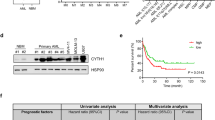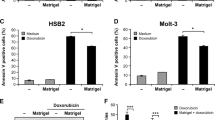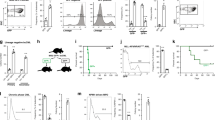Abstract
Relapses following chemotherapy are a major hindrance to patients’ survival in acute myeloid leukemia (AML). To investigate the role of the hematopoietic niche in the chemoresistance of leukemic cells, we examined two pathways: one mediated by adhesion molecules/integrins, and the other by soluble factors of the morphogen Wnt pathway. In our study, both the adhesion of leukemic blasts to fibronectin and the addition of Wnt antagonists induced, independently, resistance of AML cells to daunorubicin in a cell survival assay. Using pharmacological inhibitors and siRNA, we showed that both resistance pathways required the activity of the glycogen synthase kinase 3β (GSK3β). Moreover, the AML cell protection downstream of GSK3β was mediated by NF-κB. A link between the adhesion and the Wnt pathway was found, as adhesion of U937 on human osteoblasts, a component of the hematopoietic niche, triggered the secretion of the Wnt antagonist sFRP-1 and supported resistance to daunorubicin. The osteoblast-conditioned medium could also confer chemoresistance to U937 cells cultured in suspension, and this cell protective effect was abrogated after depletion of sFRP-1. In the context of this potential double in vivo resistance, modulators of the common signal GSK3β and of its target NF-κB could represent important novel therapeutic tools.
This is a preview of subscription content, access via your institution
Access options
Subscribe to this journal
Receive 50 print issues and online access
$259.00 per year
only $5.18 per issue
Buy this article
- Purchase on Springer Link
- Instant access to full article PDF
Prices may be subject to local taxes which are calculated during checkout






Similar content being viewed by others
References
Bendall LJ, Makrynikola V, Hutchinson A, Bianchi AC, Bradstock KF, Gottlieb DJ . (1998). Leukemia 12: 1375–1382.
Bournat JC, Brown AM, Soler AP . (2000). J Neurosci Res 61: 21–32.
Calvi LM, Adams GB, Weibrecht KW, Weber JM, Olson DP, Knight MC et al. (2003). Nature 425: 841–846.
Chung EJ, Hwang SG, Nguyen P, Lee S, Kim JS, Kim JW et al. (2002). Blood 100: 982–990.
Czyz J, Wobus A . (2001). Differentiation 68: 167–174.
Dean M, Fojo T, Bates S . (2005). Nat Rev Cancer 5: 275–284.
Demarchi F, Bertoli C, Sandy P, Schneider C . (2003). J Biol Chem 278: 39583–39590.
Deng J, Xia W, Miller SA, Wen Y, Wang HY, Hung MC. . (2004). Mol Carcinog 39: 139–146.
Fukuhara K, Kariya M, Kita M, Shime H, Kanamori T, Kosaka C et al. (2002). J Clin Endocrinol Metab 87: 1729–1736.
Ghosh JC, Altieri DC . (2005). Clin Cancer Res 11: 4580–4588.
Gradl D, Kuhl M, Wedlich D . (1999). Mol Cell Biol 19: 5576–5587.
Guzman ML, Neering SJ, Upchurch D, Grimes B, Howard DS, Rizzieri DA et al. (2001). Blood 98: 2301–2307.
Guzman ML, Swiderski CF, Howard DS, Grimes BA, Rossi RM, Szilvassy SJ et al. (2002). Proc Natl Acad Sci USA 99: 16220–16225.
Han X, Amar S . (2004). J Biol Chem 279: 2832–2840.
Hazlehurst LA, Landowski TH, Dalton WS . (2003). Oncogene 22: 7396–7402.
Hoang BH, Kubo T, Healey JH, Yang R, Nathan SS, Kolb EA et al. (2004). Cancer Res 64: 2734–2739.
Hoeflich KP, Luo J, Rubie EA, Tsao MS, Jin O, Woodgett JR . (2000). Nature 406: 86–90.
Hwang SG, Lee HC, Trepel JB, Jeon BH . (2002). Leuk Res 26: 863–871.
Ivaska J, Nissinen L, Immonen N, Eriksson JE, Kahari VM, Heino J . (2002). Mol Cell Biol 22: 1352–1359.
Jamieson CH, Ailles LE, Dylla SJ, Muijtjens M, Jones C, Zehnder JL et al. (2004). N Engl J Med 351: 657–667.
Kenny PA, Bissell MJ . (2003). Int J Cancer 107: 688–695.
Landowski TH, Olashaw NE, Agrawal D, Dalton WS . (2003). Oncogene 22: 2417–2421.
Lee JL, Lin CT, Chueh LL, Chang CJ . (2004). J Biol Chem 279: 14602–14609.
Liao X, Zhang L, Thrasher JB, Du J, Li B . (2003). Mol Cancer Ther 2: 1215–1222.
Matsunaga T, Takemoto N, Sato T, Takimoto R, Tanaka I, Fujimi A et al. (2003). Nat Med 9: 1158–1165.
Muller-Tidow C, Steffen B, Cauvet T, Tickenbrock L, Ji P, Diederichs S et al. (2004). Mol Cell Biol 24: 2890–2904.
Nelson WJ, Nusse R . (2004). Science 303: 1483–1487.
Ougolkov AV, Fernandez-Zapico ME, Savoy DN, Urrutia RA, Billadeau DD . (2005). Cancer Res 65: 2076–2081.
Prindull G, Zipori D . (2004). Blood 103: 2892–2899.
Recher C, Ysebaert L, Beyne-Rauzy O, Mansat-De Mas V, Ruidavets JB, Cariven P et al. (2004). Cancer Res 64: 3191–3197.
Reya T, Duncan AW, Ailles L, Domen J, Scherer DC, Willert K et al. (2003). Nature 423: 409–414.
Roth W, Wild-Bode C, Platten M, Grimmel C, Melkonyan HS, Dichgans J et al. (2000). Oncogene 19: 4210–4220.
Scatena M, Almeida M, Chaisson ML, Fausto N, Nicosia RF, Giachelli CM . (1998). J Cell Biol 141: 1083–1093.
Shou J, Ali-Osman F, Multani AS, Pathak S, Fedi P, Srivenugopal KS . (2002). Oncogene 21: 878–889.
Siggelkow H, Rebenstorff K, Kurre W, Niedhart C, Engel I, Schulz H et al. (1999). J Cell Biochem 75: 22–35.
Simon M, Grandage VL, Linch DC, Khwaja A . (2005). Oncogene 24: 2410–2420.
Takada Y, Fang X, Jamaluddin MS, Boyd DD, Aggarwal BB . (2004). J Biol Chem 279: 39541–39554.
Westendorf JJ, Kahler RA, Schroeder TM . (2004). Gene 341: 19–39.
Yoganathan N, Yee A, Zhang Z, Leung D, Yan J, Fazli L et al. (2002). Pharmacol Ther 93: 233–242.
Acknowledgements
We acknowledge Dr Jeff Rubin for sFRP-1 purchase and scientific advices, Pr Guy Laurent for supporting CAM-DR studies and Dr Fatima L’Faqihi for technical assistance in FACS experiments. This work was financially supported by Association pour la Recherche contre le Cancer (Grant No. 3638); Association Laurette Fugain, France.
Author information
Authors and Affiliations
Corresponding author
Rights and permissions
About this article
Cite this article
De Toni, F., Racaud-Sultan, C., Chicanne, G. et al. A crosstalk between the Wnt and the adhesion-dependent signaling pathways governs the chemosensitivity of acute myeloid leukemia. Oncogene 25, 3113–3122 (2006). https://doi.org/10.1038/sj.onc.1209346
Received:
Revised:
Accepted:
Published:
Issue Date:
DOI: https://doi.org/10.1038/sj.onc.1209346
Keywords
This article is cited by
-
Lysyl oxidase expression is associated with inferior outcome and Extramedullary disease of acute myeloid leukemia
Biomarker Research (2020)
-
Increased expression of secreted frizzled related protein 1 (SFRP1) predicts ampullary adenocarcinoma recurrence
Scientific Reports (2020)
-
POPX2 phosphatase regulates apoptosis through the TAK1-IKK-NF-κB pathway
Cell Death & Disease (2017)
-
Progress in RNAi-mediated Molecular Therapy of Acute and Chronic Myeloid Leukemia
Molecular Therapy - Nucleic Acids (2015)
-
Platelets Promote Mitochondrial Uncoupling and Resistance to Apoptosis in Leukemia Cells: A Novel Paradigm for the Bone Marrow Microenvironment
Cancer Microenvironment (2014)



